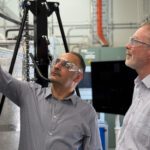Curtin University WA-Organic and Isotope Geochemistry researchers will play a key role in an international project which will see scientists drill into the 180 kilometre-wide Chicxulub Impact Crater associated with the dinosaur extinction event.
The researchers aim to understand how life recovered and repopulated Earth following the catastrophic asteroid impact event 66 million years ago.
Associate Professor Marco Coolen, geomicrobiologist and ancient DNA expert, will be the only representative from Australia to visit the drilling location in Mexico to obtain samples for the team’s research.
The drilling project, to commence in early April this year and take place over a few months, aims to reach 1,500 metres below the ocean floor into the crater’s ‘peak ring’.
The samples will be frozen and shipped to Curtin University for further analysis by the WA-Organic and Isotope Geochemistry team and the John de Laeter Centre.
As part of this unique multi-national and multi-institutional drilling and scientific effort, the researchers from Curtin hope to find evidence that will explain what happened after the bolide impact.
“Through analysing the molecular remains of life found in this crater, we hope to obtain evidence of the resurgence and evolution of marine and terrestrial life following the asteroid impact offshore at Chicxulub in the Gulf of Mexico,” Associate Professor Coolen said.
“Furthermore, we will explore to what extent the diversity of subsurface bacteria reflect post-impact environmental changes.”
John Curtin Distinguished Professor Kliti Grice, a world leading molecular fossil and stable isotopic expert of mass extinctions, said the team will be applying an innovative approach to combine geological, biological and geochemical tools to study the environmental factors accompanying life during and after the impact event.
“It is estimated that close to the impact, greater than 50 percent of species became extinct, including calcifying plankton whereas non-calcifying organisms recovered from the event,” Professor Grice said.
“This international research effort will yield critical insights into how this major mass extinction impacted the evolution of life on a planetary scale.
“Research associated with this end-Cretaceous event is the most closely related to the rise of our current CO2 concentrations, which saw the levels rise at least approximately four times more than present levels,” Professor Grice said.
Curtin University Associate Professor Fred Jourdan, a geologist and expert on Argon dating and the causes of mass extinctions, explained that this end-Cretaceous period extinction event is currently the only one that can be associated with an asteroid impact event and volcanic activity 66 million years ago.
“Other extinctions are associated solely with voluminous volcanic activity which affected the biogeochemical cycles and microbial communities in the ancient seas,” Associate Professor Jourdan said.
“One of the main research areas that we also will look at is the extent of a hydrothermal system associated with the impact and the advantages for the colonisation of life right after a major impact.
“This can have implications on how early life can colonise a planet after its formation,” Associate Professor Jourdan said.
The project is funded by the International Ocean Discovery Program (IODP) and the International Continental Scientific Drilling Program. It has been supported by the Australian Research Council (ARC) $10 million infrastructure program led by Australia-New Zealand IODP Consortium.


